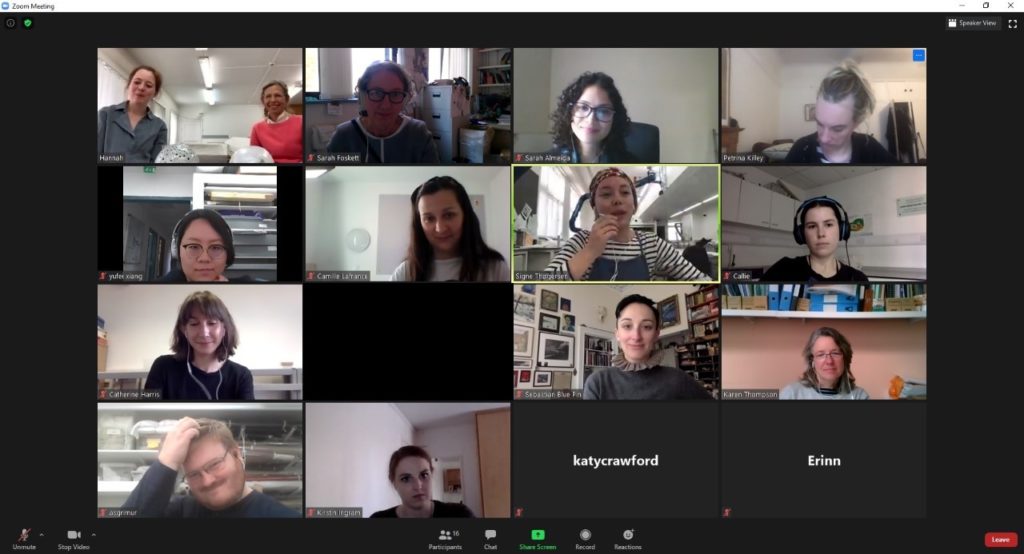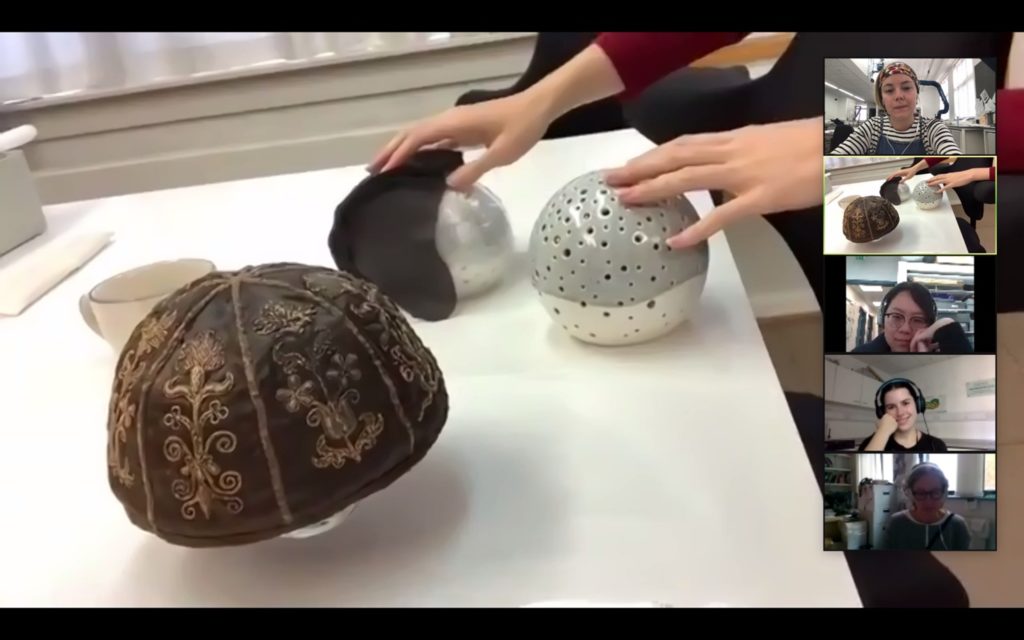
Signe Marie Thøgersen, 2nd year student.
Earlier this semester, the 1st and 2nd year students in the MPhil Textile Conservation Programme at The University of Glasgow all took a one-hour break from their studies and lab-work in order to visit the textile conservation department at The National Museum of Art, Architecture and Design – in Oslo, Norway! The visit took place virtually via Zoom and was generously hosted by textile conservators Eva Düllo and former CTC student Hannah Vickers.

Figure 1. Glasgow textile conservation students on a guided tour of the Oslo textile conservation department via Zoom by hosts Hannah Vickers and Eva Düllo (top left corner). Photo credit: Sarah Foskett.
The museum has undergone much upheaval over the past few years: the old Museum of Decorative Arts and Design closed to the public back in 2016 and is scheduled to re-open as part of the new National Museum in the new venue in 2021, in what will be the largest museum of art, architecture and design in the Nordic countries[i]. These events have resulted in many changes and challenges for the museum’s textile conservation team: they continue to work in their old premises and are now preparing to move into new storage facilities, exhibition spaces and conservation lab. The move entails the documentation, conservation and packing of over 600 textiles, as well as the mounting of at least 100 pieces of costume before the museum opens. The team estimated that it would take at least another year to complete all the mounting and installation work. Looking at the bright side, all this meant that there were a number of very interesting conservation projects to look at for the Glasgow conservation students.

Figure 2. The National Gallery[ii], former premises of The National Museum of Art, Architecture and Design in Oslo. This file is licensed under the Creative Commons Attribution-Share Alike 3.0 Unported license.
The Glasgow students were taken on a guided tour of the textile conservation lab, via Hannah’s laptop, allowing the students to get “close” to the textiles the Oslo conservators were working on.
One of Hannah’s (many) projects at the time was to come up with treatment and storage-solutions for a silk dress from the 1918-1919. The dress was in relatively good condition, but the main concern was a suspected presence of naphthalene – recognisable by its distinctive smell – which precludes wet cleaning and presents a potential health concern in connection with handling or displaying the dress[iii]. The issue of chemically treated textiles in the collection is something Hannah et al. hope to investigate in the future.

Figure 3. Hannah Vickers showed talking about the naphthalene affected dress. Photo credit: Sarah Foskett.
Eva was working on 17th century gold and silk lace worked on original thin gauze – a very rare and fragile piece of textile – that would originally have decorated the corner of a larger textile, but was separated from it before it entered the museum’s collection. The piece had previously been conserved by stitching it to a crepeline support, however, this treatment was failing and Eva was therefore providing a new stitched support, pinning out the piece during conservation to ensure it was properly aligned. This task was very time-consuming and could presumably not have been carried out under normal circumstances – but because of the move time was now available for the fragile lace to receive some much- needed treatment.

Figure 4. Metal-lace work (inventarnummer OK-02263B) during stitching-treatment by Eva Düllo. Photo credit: Sarah Foskett.
Eva was also working on a silk dress from 1909-1910 worn by Norwegian actress and singer, Frida Krohn[iv]. The silk was fragile and shattered with tears and areas of loss and in need of a support treatment. The condition suggests that the silk was weighted – a practice of treating silk with chemicals such as tin salts to increase the weight of the fabric – and thus its value – but which causes the silk to become weak and brittle over time.

Figure 5. Eva Düllo matching the 1910-1912th dress (inventarnummer OK-12906) worn by Norwegian actress and singer, Frida Kohn. Photo credit: Sarah Foskett.
Textile conservator Mariann Nestegard Vivelid’s creative mount making for various hats in the collection was also highlighted. The correct shape for each internal hat mount was achieved by padding up forms creatively constructed from various pieces of ceramic and glassware covered with felt and clingfilm. The Fosshape® was then heat activated onto the form using hot steam as well as a heated spatula in the smaller areas. Once heat-set the Fosshape® was removed from the form, creating a bespoke mount.

Figure 6. Hannah Vickers with some of the glassware and ceramics used as moulds for Fosshape® hat mounts.
At the end of the tour, questions in the Zoom-chat from students and teachers led to a debate on the pros and cons of working from home because of Covid-19 restrictions, and the challenges that come with moving into a new museum.
Being a conservator-in-training
during a pandemic can be challenging to say the least: lockdown, restrictions
and limited access to the conservation lab and practical work can at times make
the world seem small and limited, and peers and colleagues are far away.
However, unexpected benefits from working online are now becoming more and more
evident: The increasing number of online seminars, workshops, forums,
presentations and other online events has the effect of bringing the
conservation community closer than ever, uniting us across borders. Going on a
virtual tour of a museum in Norway – and meeting the conservators there – would
most likely not have been considered an option a year ago. Paradoxically one’s
textile conservation network has expanded in a time when travel is not possible.
[i] Nasjonalmuseet. “The new National Museum.” https://www.nasjonalmuseet.no/en/visit/locations/the-national-museum/. Accessed 25/10 2020.
[ii] Nasjonalmuseet. “The National Gallery.” https://www.nasjonalmuseet.no/en/visit/locations/the-national-gallery/. Accessed 25/10 2020.
[iii] Madden, O., R. Hodgkins, and S. Heald. ”Substituting SPME for noses in the detection and quantification of mothball vapors from textiles in the National Museum of the American Indian collection.” In ICOM-CC 17th Triennial Conference Preprints, Melbourne, 15–19 September 2014, edited by Janet Bridgland. Paris: International Council of Museums, 2014.
[iv] People Pill. “Frida Krohn.” https://peoplepill.com/people/frida-krohn/. Accessed 25/10 2020.

